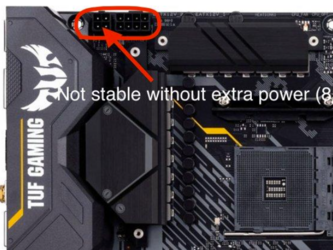New build today, but won't boot.
New:
MB: ASUS TUF X570 Gaming-Plus
RAM: Patriot Steel Series 32GB kit #PVS432G360C8K
CPU: AMD Ryzen 5 3600
Pulled from working system:
PSU: 700W (name brand, but I don't remember it)
GPU: ASRock RX570
I installed everything into the new build, and when I power up the PSU, some RGB lights appear on the motherboard. But when I try to boot up... not a thing happens. No fans, no lights, not even the debugging QLEDs on the MB will light up. I called ASUS, and after trying a few things that I had already tried myself... and then doing things like "hit delete a lot when you turn it on", after telling him it doesn't "turn on"... he finally said my MB is bad and I should return it to NewEgg for another. I didn't mind since I bought 2 motherboard for 2 builds.
But.. when I installed the second MB... all the same issues.
As for the PSU, I literally pulled it from the PC my son used for gaming this morning.
Is it common to have 2 bad motherboards or might there be something I am missing?
I started unplugging things, one after the other, hoping at some point it would turn on. But even with just the 24-pin and 8-pin power connectors, the CPU and fan... not a thing.
Including no QLED lights to help me.
I know this is a tough one to help with online, but man.. I'm stuck.
Thanks
New:
MB: ASUS TUF X570 Gaming-Plus
RAM: Patriot Steel Series 32GB kit #PVS432G360C8K
CPU: AMD Ryzen 5 3600
Pulled from working system:
PSU: 700W (name brand, but I don't remember it)
GPU: ASRock RX570
I installed everything into the new build, and when I power up the PSU, some RGB lights appear on the motherboard. But when I try to boot up... not a thing happens. No fans, no lights, not even the debugging QLEDs on the MB will light up. I called ASUS, and after trying a few things that I had already tried myself... and then doing things like "hit delete a lot when you turn it on", after telling him it doesn't "turn on"... he finally said my MB is bad and I should return it to NewEgg for another. I didn't mind since I bought 2 motherboard for 2 builds.
But.. when I installed the second MB... all the same issues.
As for the PSU, I literally pulled it from the PC my son used for gaming this morning.
Is it common to have 2 bad motherboards or might there be something I am missing?
I started unplugging things, one after the other, hoping at some point it would turn on. But even with just the 24-pin and 8-pin power connectors, the CPU and fan... not a thing.
Including no QLED lights to help me.
I know this is a tough one to help with online, but man.. I'm stuck.
Thanks
